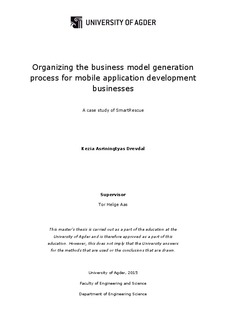Organizing the business model generation process for mobile application development businesses
Abstract
This thesis aims on getting more knowledge about how to build a sustainable business model
for mobile app businesses. A business model plays an important role in generating profit and
sustaining a company‟s competitive advantage. In a startup, the customers and the product
which customers might find valuable are still unknown. Thus, designing a business model for
a startup company involves a set of experiments and in many cases limited funding resource.
The case I am using for my thesis is a research project at the University of Agder which is
developing an app for rescue purposes, and the plan is to commercialize the app. The
examination of my case is based on a qualitative approach and the study combines an
observational approach, which includes interviews and some document readings, and a fieldexperimental
approach where I apply a tool together with the case-organization. In order to
answer my research question, I have collected information about- and analyzed the activities
SmartRescue has done during the technology development process to see which consequences
this has had for the business model generation.
The business model generation process involves experiments to test hypotheses generated for
each dimension in the business model canvas. The findings show that the customers‟ problem,
the value propositions and the potential customer segments in a business model are most
likely identified as an integrated part of the technology and product development process. The
findings also show that several dimensions in a business model are being affected by the
technology- and product development process. Furthermore, there are three essential
dimensions of the business model which need to be integrated with the product development
process: value propositions, customer segments, and revenue streams. Integrating experiments
in the business model generation- and product development process will result in a higher
chance of launching the right product to the market and shorter technology development
cycles which are cheaper than the traditional new-product introduction methods.
Description
Masteroppgave industriell økonomi og teknologiledelse- Universitetet i Agder, 2015
